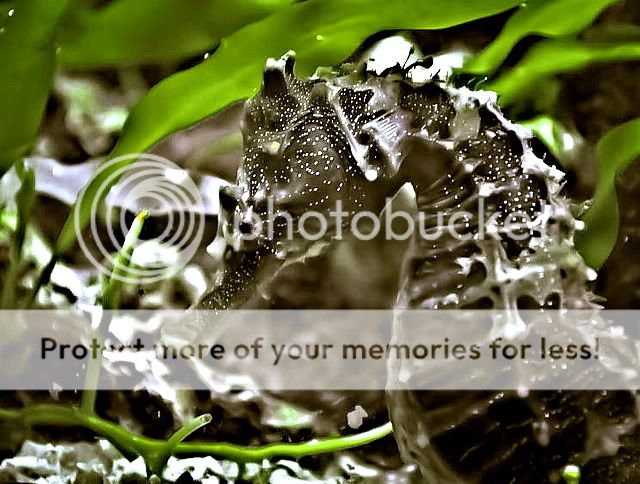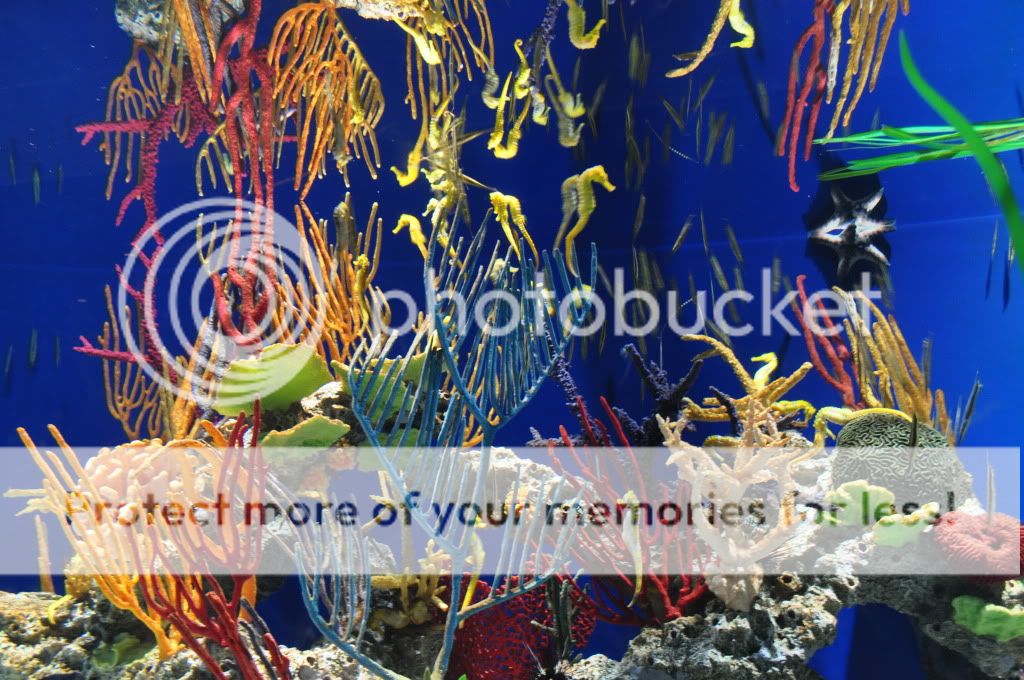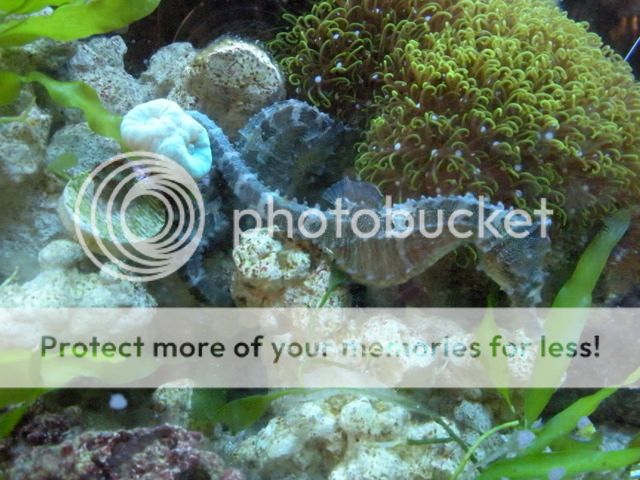little_fish
Moderator
So you would like to have seahorses?
Congratulations on picking out a wonderful marine fish with lots of personality and doing the research required to keep these wonderful animals happy and healthy.
Hopefully by now you have realized that they aren’t like other marine fish and should not just be tossed into any old reef tank. This is not a complete guide to seahorse keeping by any means, but this does provide a good overview and a baseboard for more research.

First lets start with a properly designed seahorse tank.
Seahorses do best in a species-specific tank because they are very slow and are often out competed for food when put in with other fish. They are also bothered by other free-swimming fish and are easily bullied by aggressive fish. However, like their namesake, they love to be in herds. Seahorses are the only fish you can break stocking rules with; I would say you should have at least two seahorses for every 10 gallons. This does however mean that the tank will require increased maintenance.
If after you are comfortable with the seahorses that you do have, and they are thriving you can try adding some quite, gentle fish to live with them. Some good examples of fish that do well with seahorses are pipefish, cardinals or mandarins.
A good place to check seahorse compatibility is: seahorse.org - Tankmates
Now, for the tank itself
Seahorses are vertically oriented creatures and a tall tank is better than a long one. A taller tank will also help prevent the males from developing pouch problems, which are very scary to deal with. You tank should be at least 20 inches tall, with some species requiring tanks as deep as 36 inches (H. abdominalis).
It is a myth that seahorses don’t like strong flow – what they don’t like is to be blown about. Your tank should have plenty of hitching posts for the seahorses. Some great hitching posts are macro algae’s, sponges, and gorgonians. Finger leathers are also great hitching posts. They don’t like big open areas, they like to be snuggled up to things. Having plenty of hitching posts for them is key to their happiness. For flow you can go with the traditional powerheads, just use several smaller ones instead of one large one. Mechanical filters, like the cheap HOB ones you find at walmart also are great for providing the kind of water movement seahorse like. If you do use the mechanical filters with filter material in them, be sure to change out the media every 3 days to keep water quality high. Total flow should be around 15 times the tank volume turned over per hour.

Seahorses don’t like to be in bright light all the time. They should have a few areas that are shaded so they can escape the bright lights if they feel the need to do so.
Seahorses don’t have very well developed stomach and as a result are very messy poopers (hahaha) and with a large number of seahorses in a tank good water quality can be very hard to achieve. But it is critical that you do maintain good water quality for their health. A high quality protein skimmer is a very good tool for maintaining good water quality, and regular water changes are a must. Also having large amounts of macro algae in the display tank or in the fuge can be very helpful in keeping nitrates at acceptable levels.
Many people would like to put seahorses in a reef tank, but this generally isn’t a very good idea. They aren’t naturally found in reefs anyways. But if you would like to put a few corals in there make sure that they do not have any stinging ability. The seahorses will often grab corals as hitches and stinging corals can give them sores on their tails. This means you need to keep a sharp eye out for pest anemones; they are a serious threat in a seahorse tank. Obviously, the desirable anemones are out of the question as well, they can easily eat a seahorse or sting them to death. They will usually survive the occasional sting, but if it’s happening constantly it can be very stressful to the seahorse. And like all fish, stressed fish are more likely to come down with some sort of illness and die from stress. Another thing to think about is some corals are seahorse safe, but it is not good for the seahorse to be hitching on them all the time. Corals like SPS make great hitching posts for seahorses, but the seahorse usually ends up killing the coral due to the damage they inflict.
Now then, where to get your seahorses?
Please, please, please do not buy your seahorses from the LFS unless they can prove beyond a doubt that they are from a true captive breed facility. Most seahorses at your typical LFS are wild caught or tank raise. Both of which mean you have a long uphill struggle ahead of you, they are also putting pressure on wild stock and as an endangered species, and they need every single one in the wild. If you do make the mistake of buying them wild caught, you must be able to provide them with live food every day for the rest of their lives because it very difficult to train them to eat frozen foods. They are also usually infected with worms and will need to be dewormed.
Thankfully, several true captive breeding centers to exist in the US. The seahorses that come from these facilities are trained to eat frozen mysid shrimp and have health guarantees. Another added bonus is that they are already adjusted to aquarium life.
In the author’s opinion the two best places to buy seahorses are
Seahorse Source, the ultimate place for captive bred seahorses.
and
Seahorse.com - Seahorse, Sea Life, Marine Life, Aquafarm Sales, Feeds and Accessories - Home
Both of these places are totally dedicated to their seahorses and have wonderful customer service and will be there for you over the life of your seahorse. They will happily talk to you about your seahorses and if trouble should arise with one of them, they will do their best to help you out.
H. Erectus are generally the best seahorses to start out with. They are the most hardy and forgiving. They are also not known to suddenly refuse to eat frozen food which can occasionally happen with some of the other species. The author also personally recommends starting out with all females. In the author’s experience, they have been more lively and will keep you from having to deal with pouch problems that the males can come down with. But they can change sex so its no guarantee that they will stay female. But if do want a breeding pair and would like to try your hand at raising them, they also have the easiest fry to raise.

Seahorses should be feed at least twice a day. They can be trained to eat from a feeder dish, which the author recommends. You can also hand feed them but this is very time consuming, but does allow you to check on if they are eating or not. One of the first signs of sick seahorse is a seahorse who refuses to eat.
Your seahorse should live around 7 years if properly cared for.
If you are committed to owning these majestic animals, a few great places to check out are:
Seahorse Source, the ultimate place for captive bred seahorses.
Seahorse Organisation. Keeping and Breeding Seahorses in the home aquarium.
And the best is probably: Seahorse.com - Seahorse, Sea Life, Marine Life, Aquafarm Sales, Feeds and Accessories - Home
The next best step in preparing yourself for getting seahorses is to take the seahorse lessons offered by Pete Giwojna at seahorse.com. You can email him and ask to take the classes (they are free!!) at [email protected] The seahorse lessons cover everything in depth, including how to set up a tank, cycle a tank, tank mates, how to feed your seahorses, the mating dance, disease prevention and treatment and more.
They are truly wonderful animal, but they are not for everyone. You need to be able to commit to their needs, they are not a fish that can be tossed into a tank and forgotten about. But to the dedicated seahorse owner, they are very rewarding and loving.
Congratulations on picking out a wonderful marine fish with lots of personality and doing the research required to keep these wonderful animals happy and healthy.
Hopefully by now you have realized that they aren’t like other marine fish and should not just be tossed into any old reef tank. This is not a complete guide to seahorse keeping by any means, but this does provide a good overview and a baseboard for more research.

First lets start with a properly designed seahorse tank.
Seahorses do best in a species-specific tank because they are very slow and are often out competed for food when put in with other fish. They are also bothered by other free-swimming fish and are easily bullied by aggressive fish. However, like their namesake, they love to be in herds. Seahorses are the only fish you can break stocking rules with; I would say you should have at least two seahorses for every 10 gallons. This does however mean that the tank will require increased maintenance.
If after you are comfortable with the seahorses that you do have, and they are thriving you can try adding some quite, gentle fish to live with them. Some good examples of fish that do well with seahorses are pipefish, cardinals or mandarins.
A good place to check seahorse compatibility is: seahorse.org - Tankmates
Now, for the tank itself
Seahorses are vertically oriented creatures and a tall tank is better than a long one. A taller tank will also help prevent the males from developing pouch problems, which are very scary to deal with. You tank should be at least 20 inches tall, with some species requiring tanks as deep as 36 inches (H. abdominalis).
It is a myth that seahorses don’t like strong flow – what they don’t like is to be blown about. Your tank should have plenty of hitching posts for the seahorses. Some great hitching posts are macro algae’s, sponges, and gorgonians. Finger leathers are also great hitching posts. They don’t like big open areas, they like to be snuggled up to things. Having plenty of hitching posts for them is key to their happiness. For flow you can go with the traditional powerheads, just use several smaller ones instead of one large one. Mechanical filters, like the cheap HOB ones you find at walmart also are great for providing the kind of water movement seahorse like. If you do use the mechanical filters with filter material in them, be sure to change out the media every 3 days to keep water quality high. Total flow should be around 15 times the tank volume turned over per hour.

Seahorses don’t like to be in bright light all the time. They should have a few areas that are shaded so they can escape the bright lights if they feel the need to do so.
Seahorses don’t have very well developed stomach and as a result are very messy poopers (hahaha) and with a large number of seahorses in a tank good water quality can be very hard to achieve. But it is critical that you do maintain good water quality for their health. A high quality protein skimmer is a very good tool for maintaining good water quality, and regular water changes are a must. Also having large amounts of macro algae in the display tank or in the fuge can be very helpful in keeping nitrates at acceptable levels.
Many people would like to put seahorses in a reef tank, but this generally isn’t a very good idea. They aren’t naturally found in reefs anyways. But if you would like to put a few corals in there make sure that they do not have any stinging ability. The seahorses will often grab corals as hitches and stinging corals can give them sores on their tails. This means you need to keep a sharp eye out for pest anemones; they are a serious threat in a seahorse tank. Obviously, the desirable anemones are out of the question as well, they can easily eat a seahorse or sting them to death. They will usually survive the occasional sting, but if it’s happening constantly it can be very stressful to the seahorse. And like all fish, stressed fish are more likely to come down with some sort of illness and die from stress. Another thing to think about is some corals are seahorse safe, but it is not good for the seahorse to be hitching on them all the time. Corals like SPS make great hitching posts for seahorses, but the seahorse usually ends up killing the coral due to the damage they inflict.
Now then, where to get your seahorses?
Please, please, please do not buy your seahorses from the LFS unless they can prove beyond a doubt that they are from a true captive breed facility. Most seahorses at your typical LFS are wild caught or tank raise. Both of which mean you have a long uphill struggle ahead of you, they are also putting pressure on wild stock and as an endangered species, and they need every single one in the wild. If you do make the mistake of buying them wild caught, you must be able to provide them with live food every day for the rest of their lives because it very difficult to train them to eat frozen foods. They are also usually infected with worms and will need to be dewormed.
Thankfully, several true captive breeding centers to exist in the US. The seahorses that come from these facilities are trained to eat frozen mysid shrimp and have health guarantees. Another added bonus is that they are already adjusted to aquarium life.
In the author’s opinion the two best places to buy seahorses are
Seahorse Source, the ultimate place for captive bred seahorses.
and
Seahorse.com - Seahorse, Sea Life, Marine Life, Aquafarm Sales, Feeds and Accessories - Home
Both of these places are totally dedicated to their seahorses and have wonderful customer service and will be there for you over the life of your seahorse. They will happily talk to you about your seahorses and if trouble should arise with one of them, they will do their best to help you out.
H. Erectus are generally the best seahorses to start out with. They are the most hardy and forgiving. They are also not known to suddenly refuse to eat frozen food which can occasionally happen with some of the other species. The author also personally recommends starting out with all females. In the author’s experience, they have been more lively and will keep you from having to deal with pouch problems that the males can come down with. But they can change sex so its no guarantee that they will stay female. But if do want a breeding pair and would like to try your hand at raising them, they also have the easiest fry to raise.

Seahorses should be feed at least twice a day. They can be trained to eat from a feeder dish, which the author recommends. You can also hand feed them but this is very time consuming, but does allow you to check on if they are eating or not. One of the first signs of sick seahorse is a seahorse who refuses to eat.
Your seahorse should live around 7 years if properly cared for.
If you are committed to owning these majestic animals, a few great places to check out are:
Seahorse Source, the ultimate place for captive bred seahorses.
Seahorse Organisation. Keeping and Breeding Seahorses in the home aquarium.
And the best is probably: Seahorse.com - Seahorse, Sea Life, Marine Life, Aquafarm Sales, Feeds and Accessories - Home
The next best step in preparing yourself for getting seahorses is to take the seahorse lessons offered by Pete Giwojna at seahorse.com. You can email him and ask to take the classes (they are free!!) at [email protected] The seahorse lessons cover everything in depth, including how to set up a tank, cycle a tank, tank mates, how to feed your seahorses, the mating dance, disease prevention and treatment and more.
They are truly wonderful animal, but they are not for everyone. You need to be able to commit to their needs, they are not a fish that can be tossed into a tank and forgotten about. But to the dedicated seahorse owner, they are very rewarding and loving.
Last edited:
